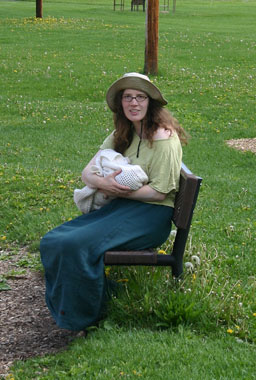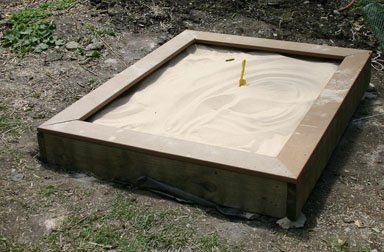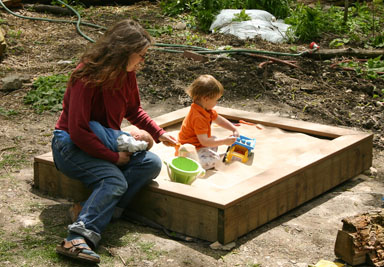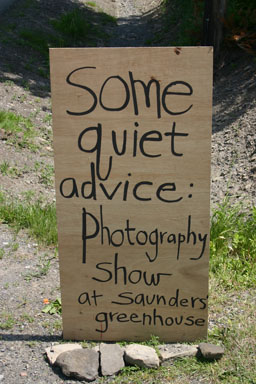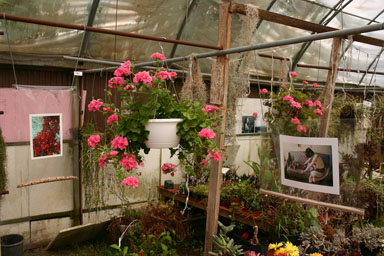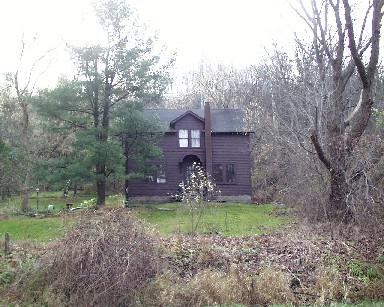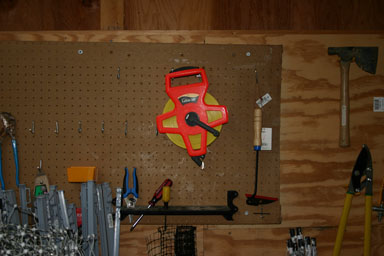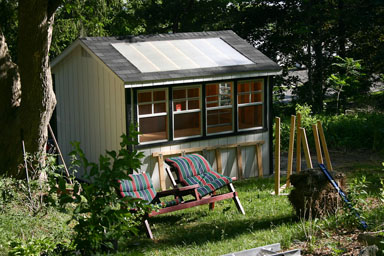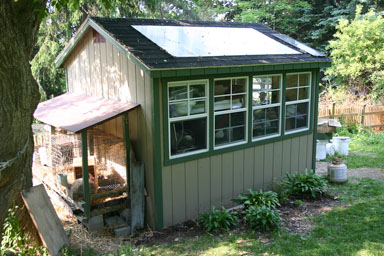May 1, 2010
Fireworks?
I know 4th of July fireworks are coming to Dryden this year, but who was the genius last night who thought it was a good idea to set of three sets of fireworks from 12:45am to 1:15am somewhere around Dryden Road and Baker Hill Road?
Before I saw the sparkles, all I could figure was that something had gone terribly wrong at the transformer station upgrade-in-progress on Pinckney Road.
Lunatic.
May 3, 2010
Dryden Community Garden meeting Tuesday night
The Dryden Community Garden, behind the Dryden Town Hall (93 East Main Street, Dryden), is on its way to getting started. If you're interested in helping organize, they're meeting Tuesday, May 4th, at the Dryden Community Center Cafe at 7:00pm.
The latest news and topics for discussion include:
- Membership forms and plot applications available.
- Garden is being plowed
- fencing being planned
- dairy day discussion
- work day planning
- open meeting at Cafe June 3
If we didn't have a newborn, I'd be there!
May 6, 2010
Lots of little bits
I don't have time to write as much as I'd like, but you should know:
Freeville has a diner again - Casey's Diner is now open where Toad's Diner was, on 38.
When I ran for Town Board last year, I talked a lot about agriculture. The Ithaca Journal has a piece on a the regional shortage of slaughterhouses, which is a key missing link. I'd love to see municipalities step up to encourage their development, while really wishing the USDA would consider rewriting their food safety rules to be (a) more effective and (b) less paperwork. They seem over the last decade or so to have decided to do fewer inspections (bad) while requiring slaughterhouses to do more paperwork (okay, but a bad substitute for inspections, and bad for small slaughterhouses). If I were Secretary of Agriculture...
The Dryden schools held a candidates forum.
Our gutless state legislative leaders remain uninterested in elections whose odds they can't tilt. Heck, Sheldon Silver is even just plain lying. I'm proud to be a Democrat at the local and national levels, but I so so wish there was a useful option at the state level. Both parties are utterly rotten there.
Cathy Wakeman reports on all kinds of things to do Mother's Day, though she missed the breakfast at the Varna Community Center from 8:00am to noon.
Sungiva's first haircut
Sungiva tangled a phone headset in her hair, so we had to trim it, and Angelika took it further to give her a real haircut.
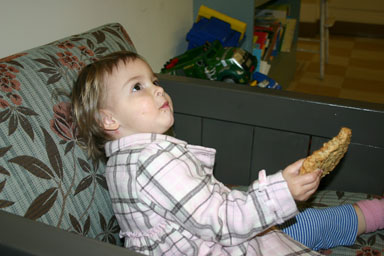
Sungiva at the Dryden Community Center Cafe.
I kind of think she looks like Julie Andrews in The Sound of Music.
Konrad's growing
I'm happy to report that Konrad is spending most of his time eating, sleeping, looking around, and getting bigger.
May 8, 2010
A sandbox for Sungiva and Konrad
Well, okay, Konrad's a little young for it still, but Sungiva's certainly happy and Konrad will grow into it.

Sungiva tests out the sandbox.
I mostly built the sandbox out of parts salvaged from last year's deck removal, though to be honest I don't love the old pressure-treated wood and hope it leached a lot of its evil content already. For the top surface, which kids will be touching all the time, I used Trex instead. The hardest parts were creating a level place for the sandbox, which meant digging out a whole cluster of root intersections and cutting them apart, and loading the sandbox with 1000 pounds of sand.
Hopefully the kids will enjoy it for a long time, and after that it should have a nice life as a raised bed for plants.
May 9, 2010
Planners and Developers as Special Interest Group
I was disappointed to find that Andres Duany, one of the writers of Suburban Nation, a book that had inspired me to rethink my views on planning years ago, has fallen into the trap of thinking that his building projects shouldn't have to work within a political process.
Here's the reporting from a recent event:
The central problem, according to Duany, is that the immediate neighbors to a proposed development are brought in to speak on behalf of the whole community. These neighbors obviously have a vested interest in what happens in their backyard, and an emotional connection to their space. They also often have a financial stake in what happens, with their life's savings tied up in their home. "We've tainted the process by not understanding that the neighbors are a special interest," says Duany. "They are not the community."
Duany, who has apparently spent too much time cloistered with clients and planners, seems to have forgotten that developers and planners are also a special interest group and not the community. His solution?
Duany's proposed solution? A randomly-chosen group of citizens, brought in to represent the community similar to the jury system. Evidently such a system is alive and well in Perth, Australia, where a group of community members is chosen randomly, brought up to speed on the issues, and asked to give input on how development should occur.
That makes a lot of sense if you're a developer - you remove people whose stake in a project might be opposing you, and get to focus your resources on convincing a much smaller group of people. It also conveniently removes the political side of these questions, the risk that elected officials take by having to decide on such things.
I mean, after all, what's the alternative?
Without such a process, Duany says, the process is taken over by "a bunch of little mobs, invited in by idiot public planners."
Duany may be "impeccably groomed", but apparently he has little understanding of the supposed public process of American government. Perhaps he misses the grand days of Robert Moses, when unaccountable officials could approve projects, demolish neighborhoods, and provide just enough insulation for elected officials that they didn't face the consequences of their decisions? Admittedly, Moses would likely have found even a small jury of random people an unacceptable annoyance in his view of the world, but I don't think this would particularly have gotten in his way.
Duany needs to remember that he's part of an especially privileged special interest group, one against which loosely coordinated neighbors who are rarely able to focus full-time resources or finances have pretty lousy odds.
Update: Duany seems to be aiming for "cranky old man" generally - his latest interview with The Atlantic practically screams "hey you kids, get off of my lawn", which I guess might mean he's a NIMBY:
There's this generation who grew up in the suburbs, for whom the suburbs have no magic. The mall has no magic. They're the ones that have discovered the city. Problem is, they're also destroying the city. The teenagers and young people in Miami come in from the suburbs to the few town centers we have, and they come in like locusts. They make traffic congestion all night; they come in and take up the parking. They ruin the retail and they ruin the restaurants, because they have different habits then older folks. I have seen it. They're basically eating up the first-rate urbanism. They have this techno music, and the food cheapens, and they run in packs, great social packs, and they take over a place and ruin it and go somewhere else.
I've known for 10 years about this destructive monoculture that's condensed in the suburbs. These people would normally be buying real estate by now. And we designed for them. We kept saying, "Aha, these kids, between 24 and 35, will be buying real estate." Guess what? They aren't. Because they can't afford it. But they're still using the cities--they're renting and so forth. The Gen-Xers also discovered the cities; they're buying in a proper way. The Millennials are the ones we're talking about. And they love cities desperately. And they're loving them to death.
None of that, of course, is a problem I've noticed too much in Dryden. I do get occasional techno from cars passing by, and Ithaca is so loaded with students that I don't think these issues would even be noticeable there.
May 11, 2010
Ag policy needs teardown, rebuild
Every now and then the people who say that government is the problem are right, though perhaps not in the way they think.
Two recent Ithaca Journal articles made clear just how strange our federal agriculture policy has become. The first looked at a local shortage of slaughterhouses, the second at Senator Schumer's plans to help apple growers pay for expensive plants.
In the first case, we tried to reduce the cost of government by looking at less food directly. For a brief and painful summary, see this Chicago Tribune article, though you have to scroll down to see the actual content. The USDA created an immense pile of paperwork, which inspectors spend a lot of time inspecting, and slaughterhouses spend a lot of time creating. If you're a big slaughterhouse, this pays off because:
After the Jack in the Box case, the USDA required each meat plant to adopt a Hazard Analysis and Critical Control Point plan. The plans let companies design their own food safety measures, usually around the need to process beef quickly....
The hope was that meatpacking plants would adopt better practices. But inspectors today say their jobs have been reduced to monitoring a company's hazard analysis plan, instead of enforcing USDA's own inspection regulations. "They [meatpacking companies] write their own plan," said one inspector, who asked to remain anonymous. "They write everything for themselves. We're 'monitoring' that now. It's just a joke. We mostly check paper now. You can put anything you want on paper."
For the small slaughterhouses, though, it's a lot of paper and a lot of regulation that doesn't necessarily make sense for a small-scale operation.
(It's not just meat inspection, either - there have been problems in the organic certification side of the FDA as well, with similar dynamics.)
As for Senator Schumer's generous offer to help apple growers buy the more expensive trees producing Gala, Honeycrisp, and Sweet Tango, there's a reason those trees are more expensive. Supply is much more limited than it is for older varieties because those varieties are patented.
And why are such things patented? Well, Gala (along with its many variations) was created privately. But Honeycrisp and Sweet Tango (as well as the Cornell varieties also mentioned in the article) come out of the land grant universities - Minnesota for these two varieties - that used to do such breeding for free. Thanks to the Bayh-Dole Act, which shifted institutions toward creating profitable patents with federal research dollars rather than expecting their government work to be for the common good. Instead of the land grant universities supporting agriculture through research that can be freely shared, they've moved into helping agriculture by selling them things.
Once again, we tried to reduce the cost of government, and it popped up someplace else. Now Senator Schumer wants the government to subsidize that someplace else.
Yes, this is crazy. I haven't even mentioned the impact of farm subsidies yet...
May 18, 2010
Great Graves of New York, Wednesday
It's way too easy to forget just how much history is all around us here in Upstate New York, and the Dryden Town Historical Society hopes to remind us:
Great Graves of Upstate New York
The final resting places of the famous will be the featured topic of the Dryden Town Historical Society's next meeting and everyone is invited to hear author Chuck D'Imperio discuss his book, Great Graves of Upstate New York.
This book is an exciting travelogue, a comprehensive reference work, and a fun and fact filled trivia book focusing on the lives (and deaths) of 70 great American legends. From Syracuse to Albany, from Buffalo to Utica, and from Cooperstown to Lake Placid, you will be amazed at who lies eternally in the Upstate region. The list includes: murder victims, mafia leaders, four U.S. presidents, three Saints, one Kentucky Derby winner and the most famous one-legged tap dancer in the world!
The event will take place on Wednesday, May 19th, at 7 PM, in the Dryden Village Hall (corner of George and South streets). The evening will begin with the Annual meeting of the Dryden Town Historical Society, a brief business session (presentation of the annual report and election of officers), followed by the featured program. Join us to learn more about the final resting places of an astonishing array of famous (and infamous) Americans. The doors will open at 6:30 PM to chat, meet the author and enjoy refreshments.
Books will be available for purchase and, as always, this event is free and open to all. For more information, contact Mary Hornbuckle (898-3461).
School elections today
We may not have any idea what the state budget will bring, but it's still time to vote on school budgets and candidates.
In the Dryden School District, polls are open from 7:00am to 9:00pm at the Dryden High School-Middle School on Route 38 between the Villages of Dryden and Freeville.
In the Ithaca School District, polls open at noon, and it's complicated. Here's a quick summary of where to vote, though you may want to check the map to be certain which district you're in:If you normally vote at BETHEL GROVE CHURCH ACTIVITIES CENTER (1749 Slaterville Rd.) (Town of Dryden, District 8), you vote at BELLE SHERMAN ANNEX (Mitchell & Cornell Sts., Ithaca).
If you normally vote IN DISTRICT 9, ELLIS HOLLOW, at VARNA COMMUNITY CENTER (943 Dryden Rd.), you vote at CAROLINE SCHOOL, 2439 Slaterville Rd.
If you normally vote IN DISTRICT 4, VARNA, at VARNA COMMUNITY CENTER (943 Dryden Rd), you still vote at the VARNA COMMUNITY CENTER.
If you normally vote at ETNA FIRE STATION (26 Wood Rd.) (Town of Dryden, Districts 1 and 5), you vote at NORTHEAST SCHOOL, Winthrop Drive, Ithaca.
Wow - that's way too complicated. I understand that Etna folks need a place to go in the Ithaca district, but why not consolidate the folks who vote at Varna in November so they vote in Varna in May? I wonder how much gasoline, lost time, and lost votes the current setup costs.
Dog for Mayor of Town of Dryden
Yes, that's a real Ithaca Journal headline, one which made me really wonder if I was seeing things. However, it's a fundraiser...
The Kiwanis Club of Dryden is hosting the first Dog for Mayor of Town of Dryden contest. This fundraising event to help support the club's many service projects is with the blessings of the Town of Dryden Supervisor Mary Ann Sumner and the Village of Dryden Mayor Randy Sterling....
Members of the community can nominate their pet by submitting a photo (such as the attached example of Rocky) with the name and current age of their dog, the owner's name, address, and e-mail address, and a $5 donation to Kiwanis received by the club by 5 p.m. Tuesday, June 1. Nominations can be mailed to the club at P.O. Box 282, Dryden, NY 13053 or submitted to a Kiwanis member. Six candidates will then be chosen at random for the "election."...
Community members may then vote for their favorite candidate by submitting the name of the candidate with a suggested donation of $1 to Kiwanis. People can vote as often as they wish for their candidate.
Let's hope this works!
May 19, 2010
DRAC to present petitions; school budgets pass
The Dryden Resource Awareness Coalition will be presenting petitions on zoning home rule and industrial noise to the Town Board tonight, having gathered 452 on noise and 389 on zoning. In a town of around 13,000 residents, that's a lot of petition signatures!
School budgets around the area passed, including Dryden and Ithaca. Dryden school board president Andrew Young and incumbent Perry Dewey were re-elected, and newcomer Karen Pastorello will join. In Ithaca, board president Rob Ainslie and vice-president Brad Grainger were re-elected, and former board member Judy Maxwell will rejoin.
In Dryden Town Talk, Cathy Wakeman reports on time-traveling Boy Scouts, the September Dryden Youth Opportunity Fair, the Dryden Beautification Brigade, and the success of local students in the Rite Aid Drug Show Quiz as well as three local farms noted as Dairies of Distinction.
Fall Creek Watershed meeting tonight in Varna
David Weinstein sent along the following announcement:
Fall Creek Watershed Committee and Cayuga Lake Watershed Intermunicipal Organization will hold four public information meetings on the development of a Fall Creek Watershed Management Plan.
At the meetings noted below, residents will have a chance to learn about and provide input into the Fall Creek Watershed Management Plan. The meetings will include an overview of the project goals, existing conditions and trends in the Fall Creek Watershed, and an opportunity to provide input on the threats and opportunities within the watershed. Anyone interested or concerned about the health and future of Fall Creek and its associated watershed should plan to attend and contribute to the discussion.
Location Date (start time 7:00 PM)
McLean Fire Hall Thursday, May 13
Varna Community Center Wednesday, May 19
May 22, 2010
Amazing exhibit at Saunders Greenhouse
Unfortunately I only got there today, and the show closes today, but hopefully these pictures can help carry what happened. The photography in the show, from a lot of different people, was very different from Mr. Saunders' own work, but the part that really amazed me was the way they used the greenhouse as a gallery, adding the photos to a lush working greenhouse.
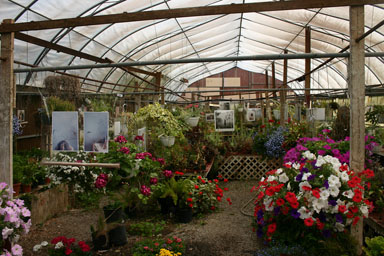
Photos throughout the greenhouse.
The photos were great, though not exactly to my taste. What really amazed me was the way these photos were hung, protected in clear vinyl cases with sand or stone at the bottom to keep them neatly vertical. Normally, I'm used to seeing photography in dull modern buildings with boring flat walls and frames designed to emphasize the photography. This, though, was much more like the way people really use pictures, often mixing them in with other furniture and objects and yes, plants.
The result was a much more alive photo exhibit than I can ever remember seeing. I hope he'll do this again. I've posted a few more pictures of the exhibit as well. (I also highly recommend his own photography, a bit of which you can see here.)
May 25, 2010
What a fence does
When we put in our fence, I was thinking mostly of creating the largest and safest defined play area for Sungiva that we could manage, while keeping things looking nice. Instead, I wound up with a great fence that's transformed the way I look at the road side of my house.
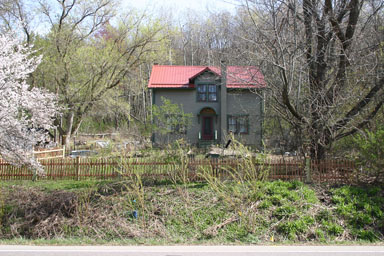
Completed fence from the road.
Before the fence, everything between the front door and the road effectively belonged to the road. We planted an orchard there, put beehives there, and raised chicks and ducks there, but most of the time we didn't go there. 366 is noisy and generally unattractive, and the view of the woods across the road is better enjoyed through the window. The hillside and ditch area were basically purgatory, unmaintained except for a few willows.
Since we put in the fence, though, the front yard feels like it's ours, despite the noise. Sungiva runs out there and we're happy about it. I'm mowing it more frequently (though maybe that's the rain, too). It's still a hard place to have a conversation, of course.
The strange part to me, though, is that I'm also now more willing to work in areas beyond the fence. The last steep slope to the ditch has always been a tangle of sumac, honeysuckle, and grapevines, but now I'm ripping those out and adding hostas and daylilies. In the farthest corner from the road, I even chopped down trees and honeysuckle for an afternoon, creating a huge amount of debris but creating a space for nicer planting.
Work in the front has also reminded me of the poison ivy infestations on the northeast and northwest corners. There's a lot to do there removing it, and it'll likely take years.
Route 366 has been carrying traffic in one form or another for thousands of years. Over the last hundred that traffic's shifted from creating places alongside it to damaging the places alongside of it. I didn't think of it this way when we built the fence, but this is one small step toward pushing that damage back.
May 31, 2010
The hideous vanity of painting a garden shed
Sometimes I finish a project, marvel at the quality I managed to put into it, and wonder why I put so much time into doing something with so little use. Today was one of those days.
A few years ago, we installed a 10'x10' garden shed, purchased from the folks at Thee Amish Market at the intersection of Route 13 and Hanshaw. I thought I posted an article about it then, but apparently I got distracted - here's a gallery of the shed preparation and arrival. It was white and black, not quite matching the house, but it had a great shelf and skylight for starting plants, and then we added a solar panel and battery to run the electric fences for the ducks and chickens.
Then I got these crazy ideas. The first one, probably a good one, was to insulate the shed. Originally, it looked like this:
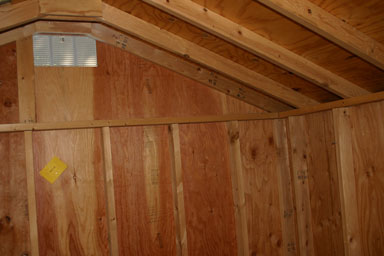
Original framed shed interior.
Now, after fiberglass insulation, plywood walls, and various stuff attached to those walls, it looks like:
The insulation, though not yet completely covered over, seems to work nicely. The shed doesn't get as hot or as cold as it used to, and this will help when we're starting plants. However, when we did that last year, a chicken got in the shed somehow and destroyed it all. This year, with Konrad's arrival, we aren't planting vegetables. So we'll see...
The next idea, though... when I got beehives, I painted them in the house colors, since those were the exterior paints I had around. Angelika built some rabbit housing, and we used those colors again. She was about to put that against the black-and-white shed, and I paused, and thought that maybe I should paint the shed to match the house. It's just a small shed, right? I got the first - smallest and simplest - wall done in a couple of days, and now it's taken me odd bits of time over two years, culminating in too much of yesterday and today, to finish the rest.
It looks great, but the amount of time it consumed cost far more than the paint that went on it. Why?
- The textured board it was built from requires huge quantities of paint for decent coverage, even on the trim.
- Tape barely works on this textured board, requiring lots of touchup after it's removed from everywhere except the windows. (I stopped using it after a while.)
- It seems clear the original builders were smart enough to paint the parts before they assembled the shed, avoiding all kinds of narrow inconveniences.
- The batten lines in the board are an extra hassle to paint, requiring a lot of time with a smaller brush heavily charged with paint.
- The shed's been in place a while, and now has plants all around it.
So after spending vast amounts of time which could have been spent on other projects - some of you, I'm sure, can think of alternatives - I have a shed that is painted in the same colors as the house, though with a slightly different use of red and no paint on the window frames themselves.
If you want a garden shed, get a garden shed. Ideally, get one in colors you like, but whatever you get, don't spend vast amounts of time changing its color. Well, there are some good reasons to consider painting it:
- Too much time (or paint) on your hands.
- Deep desire to learn more about exterior painting in challenging situations.
- Fondness for weather-dependent projects.
On the bright side, I was outside in good weather for all of this, though this weekend was a few degrees too hot. I was largely in earshot of Angelika, Sungiva, Konrad, and my visiting in-laws, though it was hard to sustain conversation while avoiding drips or climbing a ladder. I probably increased my property value by about as much as the paint cost. And, of course, I now have a shed painted in the same colors as my house.
Let's hope it lasts twenty years. Thirty?
(No, I'm not painting the fence. The cedar can weather happily without my help.)

